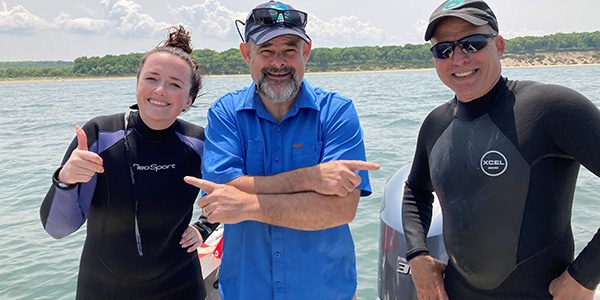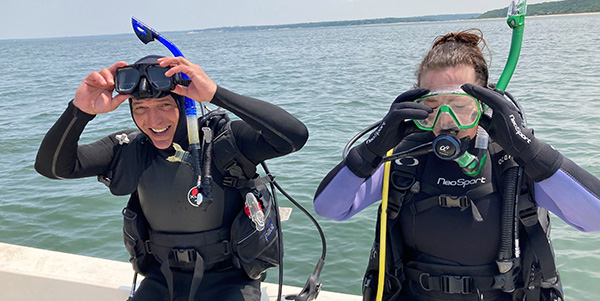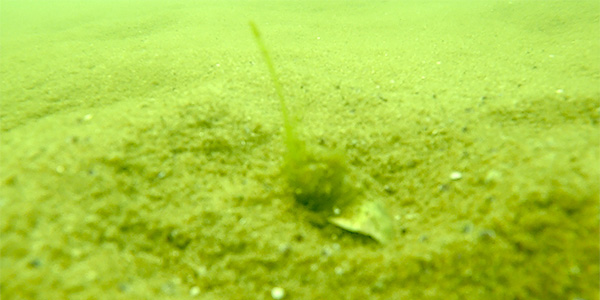
You’ve heard about the needle in the haystack, right? Child’s play.
Now, take that haystack and put it under 8 or 9 feet of seawater, maybe a quarter-mile off the bluffs and the beach. The visibility under that water is limited as the tide comes in near the middle of this late-May day – you can’t see much beyond your fingertips stretched out fully in front of you. That water is cold, by the way, no more than 58 degrees on the bottom; your wetsuit offers little protection. And did we mention that you’re searching blindly around a two-acre haystack, and you’re not entirely sure you’re in the right spot to begin with?
As for the needle, there’s no guarantee there is one. You’re hopeful, confident even. But when you’re under all that open water, you may be searching for something that simply isn’t there.
That’s what Emma DeLoughry, our Associate Soundkeeper, and Rob Vasiluth, our partner from SAVE Environmental, were up against last Monday, diving in Smithtown Bay off Sunken Meadow State Park. One day shy of six months earlier, Rob had taken a machine of his own invention onto a boat provided by the Cornell Cooperative Extension to execute a plan of his own invention. That day, Rob sprayed 8,000 live hatchery clams, each with 10 or so viable eelgrass seeds glued to its shell across two-and-a-half football fields of open water. The goal was for the clams to sink to the floor of Long Island Sound and bury themselves (as nature intended), taking with them the seeds that might take root and give birth to a new underwater meadow of eelgrass (it’s not called Sunken Meadow for nothing).
For six months, Rob and our Soundkeeper team could only wait for the day they could return to the site. Maybe some of the clams would have been swept beyond the deployment zone by washing machine currents and be rendered unfindable. Maybe some wouldn’t survive the descent through cold November waters, or maybe the turbid water wouldn’t allow light to penetrate deep enough to reach whatever sprouted. Quite likely, some would be eaten along the way.
Maybe, just maybe, some would grow. If even 10% of the seeds found their way home – the best-case, in Rob’s calculations, would be 20% made it – that’s one new plant for every clam. He’s had good results from other plantings at sites around Long Island. Maybe on this pre-Memorial Day reconnaissance dive, there would be 8,000 needles to find. There was no way to know until they were down in the haystack.

The first dive of the day turned up nothing. Emma and Rob probably were looking a few dozen yards too far to the west, pushed off course by the current. Even with coordinates marked during the dispersal, they could be just off the mark.
Preparing for dive two, Long Island Soundkeeper Bill Lucey swung the Terry Backer II around, repositioning the boat within 20 feet of the coordinates showing the transect line, and Rob and Emma went back in the water.
After 20 minutes or so, Bill noticed from the bow that Emma appeared to be hovering in place, her air bubbles surfacing in the same location. It was a good sign.
Turns out, Emma had found her first promising piece of evidence – a clam shell, cracked open and empty. On the top were little BBs of reef glue. And one eelgrass seed.
This was the right place.
Encouraged, Emma felt her way along the floor, until something caught her eye. A green shoot, maybe an inch-and-a-half high. She gently swept away some of the soil at its base, unearthing exactly what she was hoping to see. A hatchery clam.
A new eelgrass plant was born in Smithtown Bay. Maybe the first one in decades.
Minutes later, Emma and Rob returned to the boat, their dives done for the day. Emma said she was “excited,” Rob was “ecstatic.” And deservedly so.
They may not have found anything else in that immediate area on that outing, but what they did find was proof of concept – Rob’s plan for restoring eelgrass in this part of Long Island Sound was, in fact, viable. Maybe there were a few more sprouts nearby, maybe thousands. It hadn’t even been a full six months for the seeds to grow, and it might have been too early in the season to check. They will head back next month to find out.
That trip should be at least a little easier. Now, they have a clearer sense of where the haystack is. And they know – for certain – that there are needles to be found.

